 |
surfresearch.com.au
the catalogue #334 |
| home | catalogue | history | references | appendix |
|
| 1930 Harry McLaren Surf Ski, 11 ft 6" |
#334
|

| CONSTRUCTION
Hollow paddle board design of cedar planks (deck) and plywood panels (bottom) fixed over a timber frame. Stained, varnished or painted. Solid nose and tail blocks with approximately eight internal cross sections, about 16'' apart, fixed through each rail by three screws. Nails and screws. Nose ring for waist-belt or paddle leash. Metal bung at the tail fitted with a large cork plug, image right. Residual markings on the board indicate previous timber splash guard. There are two metal rings in the nose and the tail, possibly used to previously mount the board for display. |
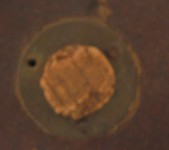 |
The ski is currently held by the Manly Art Gallery and Museum:
"Surf Ski 1933
-This is a cedar surf ski of hollow construction with a planking top and
sides screwed to an internal frame and a veneered ply bottom.
There is a
solid cedar fin, a canvas 'seat', a brass bung and top rear mooring rings
fore and aft.
The ski has
the inscription 'H. CRAKANTHORP, PORT MACQUARIE'.
Made by Harry
McLaren of Port Macquarie. MO526."
Shirley Neil: Manly
Art Gallery and Museum Catalogue Notes, November 2007.
Many thanks to Shirley
Neil and Catherine Roberts.
|
Length :
|
11
|
ft |
6
|
inches | ||
|
Width :
|
25
|
inches |
Wide Point :
|
inches | ||
|
Nose :
|
17
|
inches |
Tail :
|
8
|
inches | |
|
Thickness :
|
6
|
inches |
Pod :
|
0
|
inches | |
|
Nose Lift :
|
inches |
Tail Lift :
|
inches | |||
|
Weight :
|
kilos |
Volume :
|
litres | |||
|
Other :
|
inches |
| Nose:
pin, 5'' solid timber nose block.
Tail: round, 3'' solid timber nose block, see below. Deck Three 8'' wide cedar longtitudinal panels with a white canvas seat-area panel nailed to the timber. Nose ring for waist-belt or paddle leash, image right.. Tail bung with large cork plug. Residual markings on the board indicate previous timber splash guard. Bottom: .Two plywood panels. Rails: chine. Rocker: distinct |
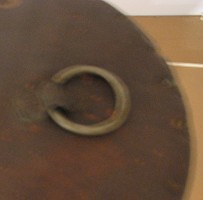 |
| DECOR
DECAL: MARKINGS Deck COLOUR Deck Multi panelled cedar deck, white canvas seat-area, image right. Bottom Plywood sections. |
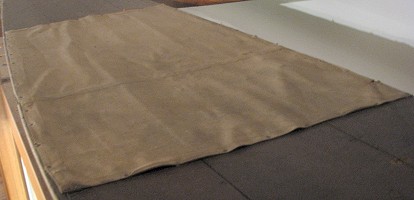 |
| FIN
3 1/2'' x 34'' base @ 2''. 3/4'' thick. Timber long base keel. |
 |
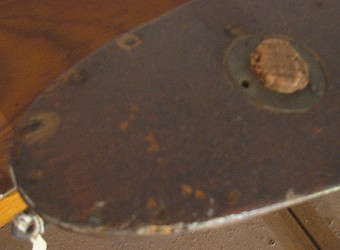
Roundtail with bung with large cork plug. |
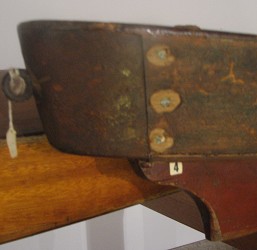
Roundtail with 3'' solid timber block. |
| ACCESSORIES
An early photograph includes a belt attached to the nose leash, an accessory perhaps only used by Harry and pre-dating the general adoption of the leg rope by surboard riders (circa 1975) by forty-five years. The Manly Art Gallery
and Museum inventory incudes the following items:
|
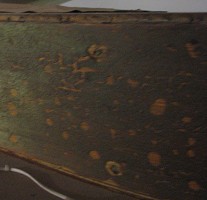
|
Shirley Neil: Manly
Art Gallery and Museum Catalogue Notes, November 2007.
Many thanks to Shirley
Neil and Catherine Roberts.
NOTES
BOARD HISTORY
Images and dimensions
Manly Art Gallery and Museum, 23 November 2007.
Many thanks to Cahterine
Roberts and Shirley Neil.
See
State
Library NSW "At Work and Play - 05010
Surf ski built
June 1930.
One made in
July 1930 and was sold to Mr Crackenthorpe for 3 pounds and is now in Manly
museum - Port Macquarie, NSW."
The surf ski is held
by the Manly Art Gallery and Museum,
catalogue number ??
The dimensions are
350 cm x 64 cm x 15.5 cm.
Imperial: 11 foot
6'' x 25'' x 6''
Specificaions: Timber
frame, cedar planking, plywood bottom, timber keel, canvas seat.
Accredition: Made
by Harry McLaren, Port Macquarie, 1933.
Providence: Donated
by Mrs. A. Crakanthorp, 1985.
- Noted by Catherine Roberts, Manly Art Gallery and Museum, in conversation, November 2007.
Significantly, the providence confirms the photographic evidence.
Note that the photograph
includes a belt attached to the nose leash, an accessory perhaps only used
by Harry and pre-dating the general adoption of the leg rope by surboard
riders (circa 1975) by forty-five years.
Bill Beale writes:
DESIGN HISTORY
From: A
History of the Surf Ski.
Port Macquarie S.L.S.C.
historian, Charles Uptin appears to consider the claims for the design
of the surf ski of Harry McLean and "Saxon' Crackanthrop of Manly as concurrent:
"There is a
local claim that the McLaren brothers, Harry and Jack ("Tacko") were the
first to ride surf skis.
They built
the somewhat monstrous, hollow skis, for use around their oyster leases
and surfed with them for pleasure.
That was in the 1920's, before the Port Macquarie Surf Club was formed, and a Harry Crakanthorp, who was town clerk here in that period, surfed with them on their skis.
Manly Surf
Club's 50 year history (Harris: Manly
SLSC (1961) page 56) says the surf ski was designed and introduced
by Dr. J. S. Crakanthorp in the 1920's.
Whichever
way it goes, fact remains that Port Macquarie has had surf skis for as
long as they have been about."
Uptin: Port
Macquarie SLSC (1979) page 33.
|
"This 1919 picture establishes Harry McLaren as the first maker of surf skis. Harry is second from the left, with Ray Dick, Herb Reckless and Bert McLaren, left to right." Uptin: Port
Macquarie SLSC
|
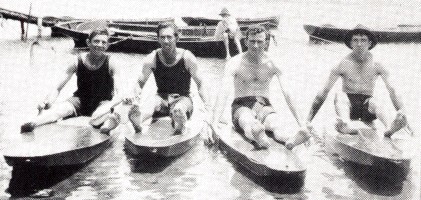 |
Further significant
photograhic evidence of Harry McLaren's design, detailed below, is online
at the State Library NSW (PICMAN):
http://libapp.sl.nsw.gov.au/cgi-bin/spydus/TRN/PM/SUHDG/211/49664
The earliest photographs
show the board (the description surf ski is questionable
at this early stage) was propelled in a sitting position with two small
hand blades, which was probably not a highly efficient method to negotiate
the surf zone.
The deck is flat
with a bung plug at the rear and a nose ring with a leash, possibly originally
required for mooring.
The rails are square
and there is pronounced rocker.
The boards' obvious
bouyancy undoubtedly indicate hollow construction (confirmed by Uptin,
above); probably thin boards of cedar fixed longtitudinally down the board.
Also see:
State
Library NSW "At Work and Play - 05005
Three men
on surf skis.
The skis were
built by Harry McLaren, one in 1912 (Spring) and the other Xmas 1913, to
his own design - Port Macquarie, NSW."
Note that this photograph
is not dated as 1913, and is probably taken sometime after the craft's
construction.
It is comtemporary
with the other image, dated 1919, noted above.
Kay Browne, Port
Macquarie-Hastings Local Studies Librarian, noted that the images
of the McLaren's were probably taken by a member of the Dick family, who
were relatives with a interest in photography.
Thomas Dick would
be renown for his images of Australian aborigines taken in the Port Macquarie
area in the 1920s, some of which are held by the Australian Museum.
See http://timbertown.com.au/pages.asp?code=104
- Noted by Kay Browne, Port Macquarie-Hastings Local Studies Librarian, in conversation, October 2007.
Citing documents held by the Manly SLSC and identified by club historian Ray Moran, Bill Beale, reported:
"Harry McLaren
was only 15 when he came up with the original design in 1912.
Prior to that,
Harry had used his Uncle Ern's duck hunting canoe to 'shoot the breakers'
near Pelican Island.
But the canoe
would 'bury its head' when coming down the face.
'
I got
a brainwave then if I built something that was on the style of a porpoise
and made the front of it fairly round and tapered off at the stern and
gave it a spring up in the front it would shoot the waves fairly good.
That was when
I was a kid 15.
Round the
latter part of 1912 I made one out of New Zealand Kauri and nailed it all
together
after Christmas in 1913 I made another one for my brother
then I went off to the War.
I still have
photos of the two skis'."
Beale, Bill: History
of the Surf Ski
http://www.manlypaddlers.com/extdoc/history_of_surf_ski.htm
Note that McLaren
saw the craft from inception as a wave riding vechicle, and makes no reference
to it's use on oyster leases.
Pelican Island is
an inland sand island adjacent to the mouth of the Hastings River and with
extreme tides and/or swells it had recognisable surfriding conditions,
although substantantial land reclaimation and the construction of a breakwater
(circa 1938) have since dramatically reduced the wave action inside the
river.
Similar surfriding
breaks are found along the NSW coast, for example Port Hacking south of
Sydney.
With their craft
stored at a boat shed on the banks of the Hasting River, the McLaren brothers
had direct access to both Pelican Island and were able to paddle to Town
Beach (see below), the first beach seaward and south of the river mouth.
"Without Doubt"
(Port
Macquarie News, 8th September, 2000) repeats the claim that the
original board was built in 1912 and notes that the family holds a copy
of "original plans", dated 12th July 1919.
- Noted by Kay Browne, Port Macquarie-Hastings Local Studies Librarian, in conversation, October 2007.
Harry McLaren enlisted
in the Australian Imperial Force on the 26th July 1915, in company with
four other Port Macquarie residents.
He embarked from
Sydney on HMAT Euripides on 2nd November 1915, achieved the rank
of Temporary Captain in the Royal Engineers and was recommended for the
Military Cross.
He was stood down/demobbed
in 1919?
Australian War Memorial Service Records, Canberra.
It exact design of "Uncle Ern's duck hunting canoe" is unclear as these craft are largely undocumented.
In its most simple
form, a duck hunting canoe was a flat bottomed punt with low gunnels,
sometimes a mere four inches deep.
It was widely used
on NSW coastal waters and the standard method of propulsion was with small
hand blades, as adopted by Harry McLaren.
- Noted by Ray Moran, Manly SLSC, in conversation, October 2007.
Shoalhaven Heads antique enthusiast, Tony Broomfield, in a phone conversation noted that duck punts (duck canoes) were originally an English design.
"DUCK PUNT
Used for the
once fashionable sport of punt-gunning or wildfowling, the duck punt or
gun punt was a type of shallow flat-bottomed craft pointed at each end
and covered over at bow and stern.
It was used
in the marshes, estuaries and rivers of the fens and the Wash, and was
usually propelled by a paddle but could also step a mast for sailing.
The fore part
of the gun punt, shaped something like an Eskimo kayak, supported the long
barrel of a muzzle-loading cannon used for shooting waterfowl including
geese, teal and shellduck.
The single
occupant was the gunner who fired at flocks of game birds, a single shot
in a day might kill as many as fifty birds.
The craft,
however, was difficult to control and easy to capsize, its navigation fraught
with dangers and discomforts.
A good example
of the use of a Gun Punt can be seen in the Royal Armouries Museum at Leeds."
Jim Shead: Rowing
and Sculling Boats
http://easyweb.easynet.co.uk/jim.shead/Boats4.html
In Australia, Tony
Broomfield indicated these were not recreational sporting craft but a commercial
hunting boat, fitted with a large bore "duck gun" primed with "grape-shot"
(nails, sinkers, metal off-cuts) to bring down a maximun number of birds
with a single blast.
One shot in the
Shoalhaven district was said to have yielded 76 birds, usually sold at
Greenwell Point for transport by ship to the Sydney market.
Tony provided the
photographs of one example from the Shoalhaven area, see below, and noted
that a second example he observed included the original hand paddles, as
reportedly used by McLaren on his board.
These were made
of a lightweight timber with thumb holes that were comfortable to grip.

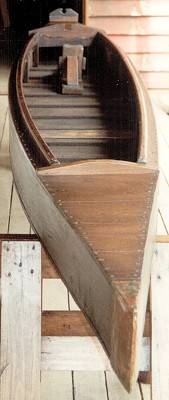 |
Duck punt, Shoalhaven River, circa 1920. (Dimensions unrecorded.) Image left:
Image right:
Image below:
All photographs circa
December 1995.
|
 |
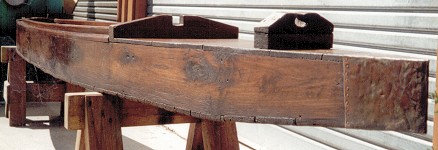
In the USA, similar craft were known as "sneakbox" and were substantially more sophisticated - a shallow draft boat with a panelled deck, usually propelled with oars and occassionally sail.
- Noted by David
Payne, Australian National Maritime Museum, in conversation October 2007.
See:
http://en.wikipedia.org/wiki/Sneakbox
The fixing of thin
timber sheets over a timber frame (carvel construction) was an established
method of small boat contruction before the turn of the century.
It was used in racing
scull or racing shell building in England since the mid 1800s.
"Eight-oared
shell (modern rowing boat)
Dating back
to 1855 when this keelless eight-oared racing boat made its appearance
at Henley on
Thames.
Designed by
Matthew Taylor, for the Royal Rowing Club, it was built, with an outer
skin of bent or
moulded cedar
wood, bottom side upwards on the moulds.
Ribs were
fitted inside the skin after the boat had been reversed.
Oxford University
launched a similar craft of their own, at Putney in 1857, 63 feet in length
and 25
inches in
beam.
...
Hulls were
made of cedar wood imported from Central America which although only three
sixteenths of an inch thick could withstand pressures of 8,000 pounds below
the waterline."
Jim Shead: Rowing
and Sculling Boats
http://easyweb.easynet.co.uk/jim.shead/Boats4.html
In Australia the sport of sculling enjoyed great popularity, the first national championship was held in 1892, and it was considered that Australian craft were lighter and faster than some English models:
"Practice boats,
of course, differ in different localities, but the light racing craft in
Australia are all of the usual "best and best" type - carvel built.
...
Without doubt
the Australian-built boat will bear comparison with any in the world.
Some few years
ago a prominent New South Wales sportsman presented an English-built eight-oared
boat to the Rowing Association, so that, if possible, the New South Wales
crew should be better boated than their rivals.
Out of compliment
to the donor the boat was used in one race; but it was generally recognized
that the crew was in reality handicapped by the sturdy craft, and after
the race she was housed - and forgotten."
Inglis(1912) page 207.
In the image below,
note that McLaren's design esentially joins the enclosed nose and tail
sections of the illustrated craft and any experienced boat builder of the
period would be able to replicate McLaren's design.
Also note the splash
guard at the prow, a feature on surf skis of the1940s.
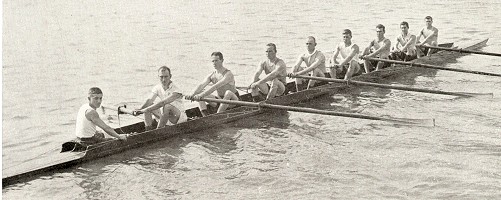
|
"The 'original' surf skis, and ' Tacko' McLaren's transport for them." Uptin: Port
Macquarie SLSClub
|
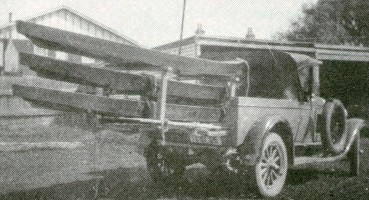 |
Around this time, a stalwart of the Manly surfing scene, Dr. J. S. 'Saxon' Crakanthorp (various spellings) apparently encounted the McLaren brothers in the Port Macquarie area and was sufficiently impressed with their craft's surfriding potential to arrange the purchase a board.
Apart from the attractraction
as a holiday resort, Crakanthorp probably had family connections with the
area before 1930 - his brother Hereward Harvey "Harry" Crakanthorp, also
a member of the Manly SLSC, served as Port Macquarie's Town Clerk from
1938 (?) to his death in 1974 (?).
As an official of
the surf life saving movement, Crackanthorp's visit coincided with the
development of the Port Macquarie Surf Life Saving Club, formally established
in 1929 with the assistance of members of the Manly and Bondi clubs.
- Noted by Kay Browne, Port Macquarie-Hastings Local Studies Librarian, in conversation, October 2007.
Certainly Harry Crakanthorp (Crakanthrope) was an active participant, Charles Uptin notes:
''The present
Port Macquarie Surf Life Saving Club was formed at a meeting held in the
Town Hall, on 24th October, 1929.
Officers elected
were: Patron, Mr. A. A. Cumming; President, Mr. H. J. Blair; Vice-presidents,
Messrs. Cyril Lewis, H. Crakanthorpe, A. Lonsdale, W. McMillan, G. Prentice,
A. C. Elliot; Treasurer, Mr. L. Atkinson; Secretary, Mr. A. Henderson.''
Uptin: Port Macquarie SLSC (1979) page 6.
Manly was a centre for surfcraft with a significant number of boardriders and the first surf life saving club to adopt the surfboat.
| Specifically, J.S.
Crakanthrop may have been influenced by Russell Henry 'Busty'
Walker, who during the 1920's used a canoe to act as a judge at the buoys
at Manly Surf Carnivals.
.Harris: Manly SLSC (1961) page 90. Manly was not the
only beach were a variety of craft were in evidence, as shown by the late
1920s photgraphic montage, right.
Image right:
|
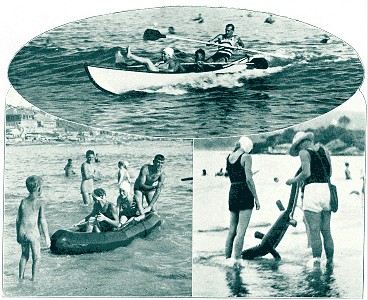
|
The surf ski is held
by the Manly Art Gallery and Museum,
catalogue number ??
The dimensions are
350 cm x 64 cm x 15.5 cm.
Imperial: 11 foot
6'' x 25'' x 6''
Specificaions: Timber
frame, cedar planking, plywood bottom, timber keel, canvas seat.
Accredition: Made
by Harry McLaren, Port Macquarie, 1933.
Providence: Donated
by Mrs. A. Crakanthorp, 1985.
- Noted by Catherine Roberts, Manly Art Gallery and Museum, in conversation, November 2007.
Significantly, the providence confirms the photographic evidence.
Note that the photograph
includes a belt attached to the nose leash, an accessory perhaps only used
by Harry and pre-dating the general adoption of the leg rope by surboard
riders (circa 1975) by forty-five years.
Bill Beale writes:
.
"Of particular
interest, when using his ski, Harry McLaren did not use the now conventional
double-bladed paddle.
He used two
square butter-bats (like square table tennis bats, 15 cm wide by 35 cm
long) strapped to each hand.
He used these
while kneeling on his surf ski.
"They work
a damn lot better than today's paddles
if knocked off, a ski paddler
would not be separated from the paddles.'
The rider
also had a rope tied to the waist and the ski.
Harry also
proffered that the kneeling position offered less wave resistance than
the present seated method."
Beale, Bill: History
of the Surf Ski
http://www.manlypaddlers.com/extdoc/history_of_surf_ski.htm
Indeed, if others followed Harry McLaren's advice and used the separate hand blades and rode and paddled in a kneeling position, then the craft would be a surfboard.
Importantly, Crakanthrop
significantly improved propulsion, and surf suitability, by introducing
a two bladded canoe paddle instead of McLaren's two small hand blades.
Also note the short
stub keels at the tail, noted above, are illustrated in this image.
See
"At Work and
Play - 05011
Three surf
skis on the back of a 1928 Chevrolet utility in the backyard at 23 Gore
Street.
The paddle
on the side belonged to Mr Crackenthorpe from Sydney - Port Macquarie,
NSW
January 1931."
Certainly these developments
in northern NSW occurred independently of the hollow board experiments
carried out, most famously, by Tom Blake in Hawaii from 1926 to 1931, and
others elsewhere.
By 1932, the "boards"
were ridden in a sitting position and propelled with a double bladed
paddle, convieniently attached to the nose leash, and fitted with
foot straps, thus definitely identifiable as surf skis.
McLaren also sold
other surf skis, in some cases less than the premium paid by Dr. Crackanthorp.
See
State
Library NSW "At Work and Play - 05008
Surf skiing
off Town Beach.
All skis built
and designed by Harry McLaren.
Sold one ski
to his cousin for 10 shillings - Port Macquarie, NSW c 1932."
For other photographs
of Surf skis in surf circa 1932, see 05006, 05007 and 05009.
05020 notes:
"Three men with
surf skis at Town Beach.
Ray Dick bought
his ski from Harry McLaren for 10 shillings and a carburettor - Port Macquarie,
NSW c 1932."
From the earliest
days of surfbathing, Town Beach was the easiest accessed location for most
residents.
It was prefered
to Flynns Beach, which was later to be developed and became the site for
the Port Macquarie Surf Life Saving Clubhouse in 1956.
From the late 1930's,
surfriding conditions at Town Beach were substantially modified with the
construction and extension of breakwaters at the mouth of the Hastings
River to maintain a navigatable entrance.
"Before the southern breakwall was extended sightly, before the original north wall was completed (it was also extended) favourable surfing conditions prevailed at Town Beach towards the southern wall, and the beach being handier to town it was more infavour than Flynn's Beach."
Uptin: Port Macquarie SLSC (1979) page 7.
The image of Town
Beach below is circa 1935, before the construction of the northern breakwater
between 1935 and 1939.
- Noted by Kay Browne,
Port Macquarie-Hastings Local Studies Librarian, in correspondence, November
2007.
It illustrates the
extensive banks in the river mouth to the north of Town Beach and lines
of swell running upriver towards Pelican Island.
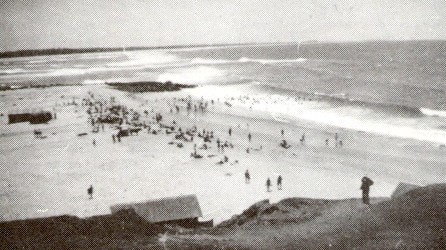
"J S Crakanthorp's
brother, Harry Crakanthorp, was the Town Clerk of Port Macquarie from 1938
till his death in the early 1970s.
According
to a mutual friend of the Town Clerk, Mr R Lindsay of Wamberal, Harry Crakanthorp
always attributed the building of the first surf skis to Harry McLaren
of Port Macquarie.
Harry Crakanthorp's
brother , Sacka, had visited him at Port Macquarie, had used McLaren's
ski, and took its measurements and the idea back to Sydney."
Beale, Bill: History
of the Surf Ski
http://www.manlypaddlers.com/extdoc/history_of_surf_ski.htm
The surf ski purchased from McLaren is likely the craft Crakanthrop brought back to Manly, accredited as his design by C. Bede Maxwell in 1949:
"Maroubra,
too, has become tlle favoured home of that purely Australian invention,
the surf ski.
This contrivance
represents what is more or less a logical development of the hollow surf-board,
and it made its first appearance under the hands of Dr G. A. ("Saxon")
Crackanthorp (sic), an enthusiast who couldn't acquire the
trick of managing a standard surfboard as well as he wished to.
He fashioned
a something that was wider in the beam, with a turned-up nose, the centre
of gravity set low, and presently found he could negotiate even the biggest
breakers without capsizing. Hollow-decked, buoyant, steered and driven
with a paddle, the surf ski sets the rider above water, and possesses all
the advantages of a canoe, plus stability.
It also lacks
the disadvantage of likely filling up, and is easier to control; the rider
sitting with his feet in straps can lean inboard or outboard in any direction
that the requirements of balance dictate.
The first skis
were built of cedar planking, so heavy that it took a man all his time
to carry one.
Later, laminated
plywood bonded with resin was substituted.
The earliest
models were about 8ft. by 28in., with a 6-inch depth and a l2-inch spring
in the keel. Competition drew these out longer, often narrower.
Big modern
"double" skis are almost as long as a standard surf- boat."
Maxwell (1949) page 245.
While the length
is probably under-estimated by Maxwell (the photographs indicate a length
of approximately ten feet), the other dimensions appear consistent with
the Port Macquarie photographs.
Note that she does
not specify a date for the introduction of the surf ski and considers it
as "a logical development of the hollow surf- board" as designed
by Tom Blake and first built in Australia by Frank Adler at Maroubra in
1934.
Maxwell
(1949) pages 240-241.
Critically, the development
of the hollow surf ski by Harry McLaren at Port Macquarie would appear
to pre-date or, at least, coincide with Blake's experiments in Hawaii.
Specifically the
report that "the first skis were built of cedar planking" would
appear to describe McLaren's design based on the duck punt and a construction
method familar to Sydney boat buiders, and not derived from Blake's hollow
surfboard.
The earliest publication
of Blake's design in1933 indicated the use of plywood or (the structually
questionable) "Masonite Tempered Presdwood" over a spruce frame.
Paul W. Gartner:
Hawaiian
Water Sled, page 86.
Dr Crakanthrop is
subsequently credited with the design of the surf ski by John Bloomfield
(1959) and Reg S. Harris (1961), probably based on the Maxwell's report.
Note that Bloomfield
dates the introduction of the surf ski as "about 1933", consistent
with the claim of Crakanthorp and Toyer's patent and before Maxwell's (and
his own, page 61) report of the first hollow surfboard, circa 1934:
"The surf ski
is a cross between a surf board and a canoe.
It can now
be seen on most Australian surf beaches, and is also popular in South Africa,
New Zealand, Ceylon and England.
The ski is
purely an Australian innovation, having been invented by Dr G. A. Crackenthorp
(sic) of Manly Surf Life Saving Club about 1933.
The early
model was heavy and short compared to those we see today, being only 8
feet long and 28 inches wide, 6 inches in depth and with a 12-inch spring
in the keel."
Bloomfield: Know How in the Surf (1959) page 69.
Harris' account notes Saxon Crakanthorp's surfing and athletic abilities, consistent with his interest in the surf ski, but does not record a relevant date for the introduction of the surf ski at Manly.
"The surf-ski
was designed and introduced by Dr. J. S. Crakanthorp, who was one ot our
outstanding members in the club's golden era of success- the 1920's.
In addition
to being one of the club's strongest swimmers, with a long string of wins
in the belt and in Cecil Healy Memorial Shield events, Saxon Crakanthorp
toured New Zealand with the N.S.W. Rugby Union team of 1923."
Harris: Manly SLSC (1961) page 56.
Uptin's claim in The History of Port Macquarie SLSC (1979) that:
By the early 1930s,
Bronte, Bondi, Maroubra and Freshwater SLS Clubs had tested a variety of
canoes in the surf and a canoe race was listed in the program of the 1930
Australian Championships at Manly, an event noted for its large surf.
No results were
recorded but canoe races were popular at carnivals between 1931 and 1935.
Maxwell
(1949) page 237, Galton
(1984) page 43, Myers
(1983) page 85.
In 1933 Jack Toyer
of Cronulla and Dr. J. S. Crakanthrop (the later possibly looking to recoup
his initial investment of 3 pounds) registered a patent for the surf ski.
Wells:Sunny
Memories (1982) page 155.
Harry McLaren's recollections appear to confirm these developments:
"He (Crakanthorp)
was
entrepreneurial and took out a patent on it.
Harry said
that during the winter of 1933 he read in the Evening News '
that there
was to be a new surf boat of some description to be introduced to the beaches
in the spring of 1933.
Then Dr Crakanthorp
got the credit of inventing the surf ski
But he didn't make them.
He had a friend
called Jack Toyer who was a boat builder
I met him and he said they'd
made a lot of money
'."
Beale, Bill: History
of the Surf Ski
http://www.manlypaddlers.com/extdoc/history_of_surf_ski.htm
Note that E. J. Thomas, writing of surf skis at the Dee Why SLSC, adjusts the players and the locations but the dates correspond roughly with the McLaren-Crakanthorp account and also parrallel the dates of Blake's Hawaiian experiments.
"first appearance on Newcastle beaches during the 'twenties, and came to Deewhy about 1932."
Thomas (1962) page 31.
As introduced to
Manly by Dr. Crakanthrop, the surf ski proved popular (detailed in C. Bede
Maxwell's assessment, above), probably due to the the ease of paddling
as a result of the high bouyancy in comparison with the solid timber surfboards
of the period.
Compared to canoes,
the enclosed deck completely avoided the possibility of the craft being
swamped by a wave.
Critically, the
high floatation, the stability of the rider while sitting and the ability
to adjust the craft speed by paddling meant that the rider could avoid
the breaking curl and safely take a straight line towards the beach, similar
to surf boats.
While the skis could
(and did) tranverse the wave face, this feature encouraged their use at
many beaches that generally did not have suitable conditions for quality
(that is, transverse) surfboard riding.
Construction would be further improved in with the replacement of cedar planking with plywood (replicating Blake's hollow board specifications) and the design made more surf friendly with the addition of footstraps.
|
Interestingly, the nose leash, now affixed to the paddle, continued to be used into the 1940s before disappearing with the construction of longer and narrower skis more suitable for SLSC competition. Initially paddled and ridden sitting on the board, in the hands of skilled riders the skis enjoyed a short period of popularity ridden standing up, possibly at the time rivalling surfboards in populatity. Image right:
|
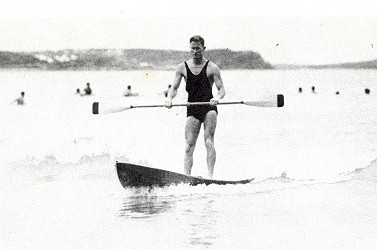
|
It is impossible
at this point to assess to what extent McLaren's hollow surf ski design
impacted on the development of the hollow surfboard in Australia.
While Harry McLaren's
relative isolation in Port Macquarie certainly implies he was unaware of
Tom Blake's experimental boards, it is possible that Crakanthrop became
aware of Blake's patent of 1931.
He may have seen
a copy of Blake's plans (including mention of the patent) published in
Modern
Mechanix magazine in 1933 and recgonised an opportunity, with possible
financial advantage, to apply for an Australian patent.
An analysis of the
claims for the first successful hollow surfboard in Australia is outside
the scope of this paper, suffice it to say a current favoured candidate
is Frank Adler at Maroubra, circa 1929-1934.
REFERENCES
Books
Maxwell,
C. Bede Surf : Australians Against the Sea
Angus and Robertson,
Sydney 1949.
Harris,
Reg. S. The History of Manly Life Saving Club 1911-1961
Published by Manly
Life Saving Club, NSW Printed by Publicity Press Ltd. 1961
Margan,
Frank and Finney,
Ben R.: A Pictorial History of Surfing
Paul Hamlyn Pty
Ltd, 176 South Creek Road, Dee Why West, NSW 2099.1970.
Galton,
Barry Gladiators of the Surf
AH & AW Read
Pty Ltd, 2 Aquatic Drive Frenchs Forest NSW 2086 1984
Thoms, Albie: Surfmovies The Blue Group PO Box 321 Noosa Heads Queensland 4567. 2000.
CONDITION: 8


| home | catalogue | history | references | appendix |